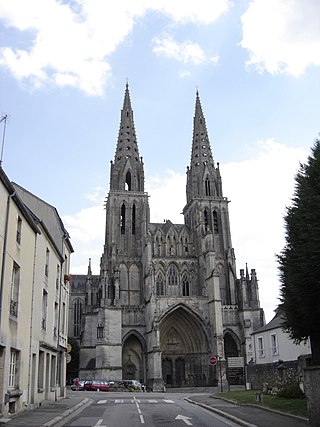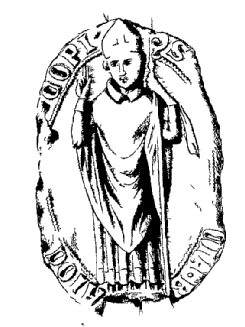Related Research Articles

Maine is one of the traditional provinces of France. It corresponds to the former County of Maine, whose capital was also the city of Le Mans. The area, now divided into the departments of Sarthe and Mayenne, has about 857,000 inhabitants.

Sées is a commune in the Orne department in north-western France. It is classed as a Petite Cité de Caractère.

The Archdiocese of Rouen is a Latin Church archdiocese of the Catholic Church in France. As one of the fifteen Archbishops of France, the Archbishop of Rouen's ecclesiastical province comprises the greater part of Normandy. The Archbishop of Rouen is currently Dominique Lebrun.

The Diocese of Bayeux and Lisieux is a Latin Church diocese of the Catholic Church in France. It is coextensive with the Department of Calvados and is a suffragan to the Archdiocese of Rouen, also in Normandy.
Ouche Abbey or the Abbey of Saint-Evroul is a former Benedictine abbey in Normandy, located in the present commune of Saint-Évroult-Notre-Dame-du-Bois, Orne, Normandy. It has been classified as a Monument historique since 1967 and is designated "classé".
Rodulf of Ivry was a Norman noble, and regent of Normandy during the minority of Richard II.

William Bona Anima or Bonne-Âme was a medieval archbishop of Rouen. He served from 1079 to 1110.

Gisela was a Frankish princess who was married to Rollo, Duke of Normandy. It is uncertain whether Gisela existed.
Wulfad was the archbishop of Bourges from 866 until his death. Prior to that, he was the abbot of Montier-en-Der and Soissons. He also served as a tutor to Carloman, a younger son of King Charles the Bald. Carloman succeeded Wulfad as abbot of Soissons in 860.
Wenilo was the archbishop of Sens from 836 or 837. Prior to becoming bishop, Wenilo was a palatine chaplain. As bishop, he was one of the leading men in Aquitaine and crowned Charles the Bald king in 848, definitively uniting Aquitaine with West Francia. In 858, he supported the East Frankish invasion and was denounced as a traitor by the king. They reconciled the next year, and Wenilo retained his office until his death. Nevertheless, he passed into legend as Ganelon, the archvillain of the Matter of France, his name a byword for "traitor".
Avitus of Rouen, also known as Avitien or Avidien was the third Bishop of Rouen. He is venerated as a Saint in the Catholic Church.
Pierre Bouet is a 20th-century French historian specializing in Norman and Anglo-Norman historians of Latin language.
Bishop Radbod (Radbodus) was a French prelate of the 11th century.
Azonthe Venerable was a prelate of the late 10th and early 11th century.
Richard fitz Samson, also known as Richard of Dover, was the bishop of Bayeux at the beginning of the 12th century.

Thomas de Fréauville was a bishop of Bayeux of the 13th century.
Henri de Pardieu was a bishop of Bayeux at the end of the 12th century (1165-1205).
Hugh of Ivry or Hugh of Bayeux was bishop of Bayeux and count of Ivry from the beginning of the 11th century.
Walter I was a French Count of the Vexin, Amiens and Valois from 943 to 992.
Walter II, the White (955-c.1024), was a French Count of the Vexin, Amiens and Valois from 992 to around 1024.
References
- Notes
- Citations
- 1 2 Bauduin 2004, p. 108.
- 1 2 3 4 5 Pommeraye 1667, pp. 207–15.
- 1 2 Nelson 1992, p. 193.
- ↑ Neveux 2009, p. 69.
- 1 2 Bauduin 2004, pp. 122–26.
- Sources
- Bauduin, Pierre (2004). La première Normandie (Xe–XIe siècle): Sur les frontières de la haute Normandie: identité et construction d'une principauté. Caen: Presses universitaires de Caen.
- Nelson, J. L. (1992). Charles the Bald. London: Longman.
- Neveux, François (2009). L'aventure des Normands: VIIIe–XIIIe siècle. Paris: Perrin.
- Pommeraye, François (1667). Histoire des archevesques de Rouen. Rouen: L. Maurry.